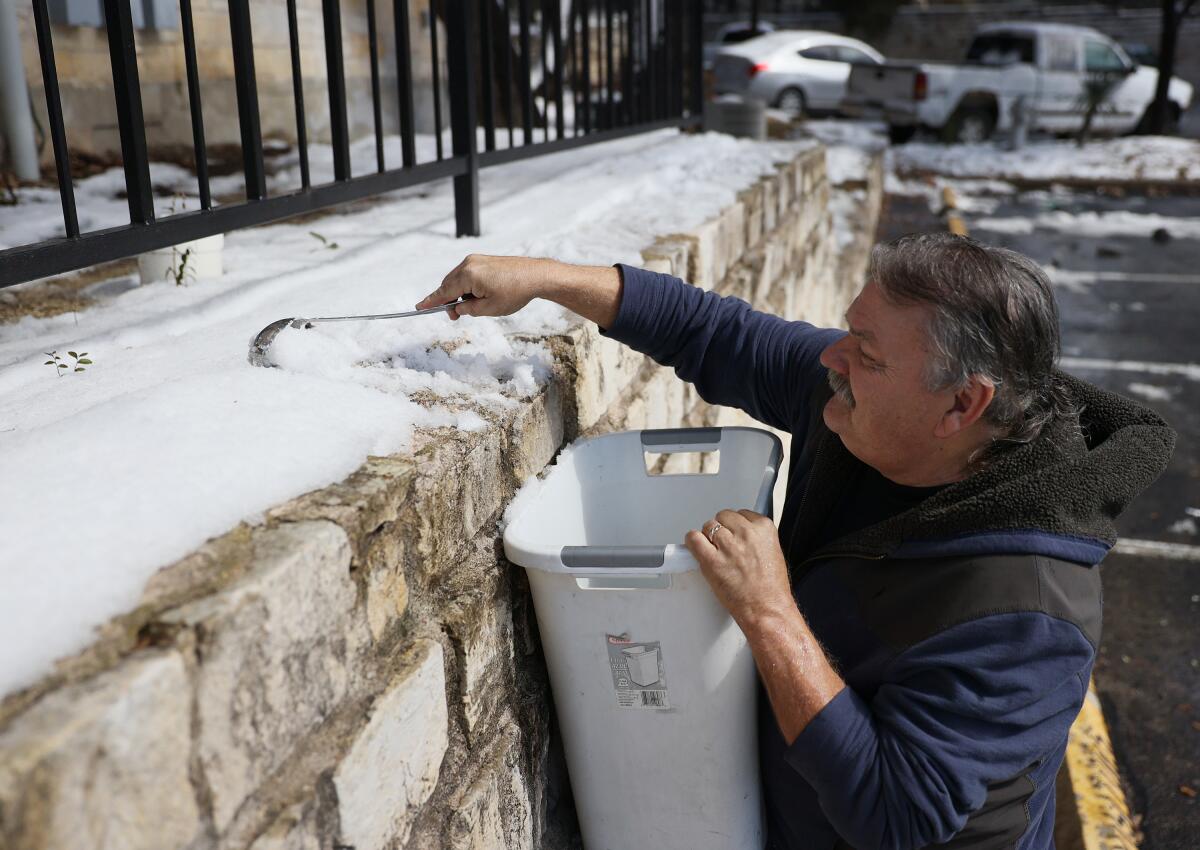Op-Ed: Don’t be smug about Texas’ troubles. California isn’t prepared for disasters either

The collapse of the power grid in Texas last week, and the cascading infrastructure failures that resulted from it, are stark examples of why a proactive government matters. A complete evaluation will surely show that, like most accidents and failures, many factors played a role, but it is already easy to see that the avoidance of government regulation contributed to the cold-weather chaos.
As we watch Texans of every socioeconomic level struggle to keep warm and access water, it would be easy for those of us living in a state that embraces government regulation to feel smug that we couldn’t have these problems. It would also be a mistake. Government regulation only affects the things we choose to regulate and the degree of pain we are willing to take into account. Our state by no means has chosen to grapple with all — or even most — of the problems we know we will face in future natural disasters.
California has a stellar record of preparing for the earthquake we just had. Seismic safety regulations began in California after the 1933 Long Beach earthquake destroyed 70 schools and killed 120 people, primarily those who ran outside and were hit by falling bricks from the collapsing buildings. So the Field Act requiring public schools to be built to a higher standard and the first seismic provisions in building codes, banning unreinforced brick buildings, came soon after. The failure of hospitals and the Lower Van Norman Dam in the 1971 Sylmar quake gave us the Hospital Safety Act and a seismic reevaluation program at the Division of Safety of Dams. After the 1989 Loma Prieta quake caused freeway and bridge collapses in the San Francisco Bay Area, Caltrans embarked on a major bridge retrofitting program.
The problem with this approach is obvious. It isn’t proactive, even though the need represented in each of those examples — much like the need to winterize energy sources in Texas — was well known before the shaking started.
Consider California’s water systems. That they are not designed for what is coming seismically is no secret. Southern California still imports most of its water, and all of that imported water has to cross the San Andreas fault to get to us. None of those crossings has been engineered to work after the San Andreas breaks, and the Los Angeles Department of Water and Power has estimated that it will take 18 months to repair all of them.
Even if we get water to the city, we also have to get it into our homes. We see broken pipes even in magnitude 5 earthquakes; in a magnitude 7 event, the area of strong shaking will be a hundred times larger, with so many broken pipes and with water pressure dropping over such a large region that millions here or in any other urban areas where a magnitude 7 could strike could be without potable water for weeks or even months. Think of the impact.
But just as in Texas, what we know has not created the political will to require municipal utilities or the thousands of private water companies in our state, which operate on tight budgets, to invest in earthquake-resistant pipes. Even though new technologies can provide us with safer pipes at competitive prices (much lower than they once were), I don’t expect the state or local governments to act to fix the problem until people suffer (or worse) from lack of water.
In some realms, especially building codes, we do try to design for future disasters and run into a different problem. Engineers can make a structure more safe or less safe, but few human systems can be perfect. We have left it to the engineers to decide how much safety is enough. This has evolved over time to a building code that prioritizes protecting lives against death (society’s demand) while minimizing the initial cost to build the structure (the builders’ demand). We’ve decided it’s OK if buildings are a total loss, as long as no one gets killed.
But is that the right standard? The short-term benefit to the builder means a long-term cost to society: Tenants will survive, yes, but they will lose their homes or businesses; neighborhood blight will follow along with disruption to the overall economy. These costs often match or exceed the direct damage to the structures, and they are paid by us all. There is also a cost to human lives beyond the immediate. According to a new study from the University of Delaware, counties that suffer a major natural disaster see the rate of suicide increase by 23% in the next three years.
Climate change is increasing the rate of weather-related disasters throughout the country. In Los Angeles, we all know the threat of a major earthquake is ever present. We cannot afford to plan only for what we have already seen or to pretend that saving lives during the shaking, the fire, or the cold snap is enough. We need to acknowledge the real foreseeable costs of the disasters we face, and as a community, decide how much more safety, and economic security, we want. And then we need to regulate to get it.
Seismologist Lucy Jones is the founder of the Dr. Lucy Jones Center for Science and Society and the author of “The Big Ones.”
More to Read
A cure for the common opinion
Get thought-provoking perspectives with our weekly newsletter.
You may occasionally receive promotional content from the Los Angeles Times.










